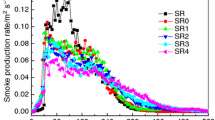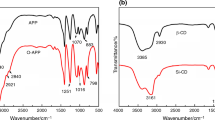Abstract
The range of application for silicone rubber (SR) is limited due to its poor flame retardant and antistatic properties. For the purpose of improving SR properties, in this study, a core–shell structured carbon nanotubes (CNTs)/cobalt copper hydroxide (CuCo-DH) hybrid was successfully prepared by a hydrothermal method, with cobalt copper hydroxide (CuCo-DH) as its core and carbon nanotubes (CNTs) as its shell. CNTs/CuCo-DH hybrid was added to SR to prepare an SR composite material, and the effect of the hybrid on flame retardancy and antistatic properties of the SR material was investigated. The cone calorimeter test (CCT) results showed that the total heat release (THR) of the SR composite with the addition of 3 phr of CNTs/CuCo-DH decreased by 25.2%, its peak heat release rate (pHRR) decreased by 31.2%, and its total smoke production (TSP) decreased by 28.1%. In addition, with 3 phr of CNTs/CuCo-DH hybrid added, the volume resistivity of the SR composite decreased from 1.96 × 1014 to 3.52 × 1010 Ω·cm, which met the requirements of antistatic materials. Therefore, the prepared new SR/CNTs/CuCo-DH composite would help to expand the range of applications of SR materials. In addition, the residual char of the composite was analyzed by SEM, FTIR and XRD, and the fire retardant mechanism was studied in detail.
Graphical abstract














Similar content being viewed by others
Data availability statement
The data that support the findings of this study are available from the corresponding author upon reasonable request.
References
Bazli L, Khavandi A, Boutorabi MA, Karrabi M (2021) Morphology and viscoelastic behavior of silicone rubber/EPDM/Cloisite 15A nanocomposites based on maxwell model. Iran Polym J 25:907–918
Balachandran GB, David PW, Alexander AB, Mariappan RK, Balasundar P, Parrthipan BK (2021) Saccharum barberi grass bagasse ash-based silicone rubber composites for electrical insulator applications. Iran Polym J 30:1285–1296
Liu W, Chen W, Dong H, Piao J, Ren J, Wang Y, Wang Y, Feng T, Jiao C, Chen X (2022) Covalent synthesis of 3-chloropropyltrimethoxysilane onto para-aramid nanofibers for TPU composites: flame retardancy, toxicity reduction, and mechanical property. Mater Today Commun 31:103355
Du WN, Yin CL, Huang H, Ge XG (2022) Vinyl-functionalized polyborosiloxane for improving mechanical and flame-retardancy performances of silicone rubber foam composites. Polym Int 71:124–131
Song P, Zhang Y (2022) Vertically aligned carbon nanotubes graphene/cellulose nanofiber networks for enhancing electrical conductivity and piezoresistivity of silicone rubber composites. Compos Sci Technol 222:109366
Qian Y, Han H, Li L, Qiao P, Zhao R, Zhang H (2020) Combustion behavior and thermal stability of TPU composites based on layered yttrium hydroxides and graphene oxide. J Therm Anal Calorim 142:409–423
Vineet Kumar Md, Alam N, Manikkavel A, Song M, Kumar V, Alam MN, Manikkavel A, Song M, Lee DJ, Park SS (2021) Silicone rubber composites reinforced by carbon nanofillers and their hybrids for various applications: a review. Polymers 13:2322
Kumar V, Lee DJ (2017) Studies of nanocomposites based on carbon nanomaterials and RTV silicone rubber. J Appl Polym Sci 134:44407
Kumar V, Lee G, Choi J, Lee DJ (2020) Studies on composites based on HTV and RTV silicone rubber and carbon nanotubes for sensors and actuators. Polymer 190:122221
Kumar V, Azam S, Alam MN, Hong WB, Park SS (2022) Novel rubber composites based on copper particles, multi-wall carbon nanotubes and their hybrid for stretchable devices. Polymers 14:3744
Lee JY, Kumar V, Tang XW, Lee DJ (2017) Mechanical and electrical behavior of rubber nanocomposites under static and cyclic strain. Compos Sci Technol 142:1–9
Chang MR, Li YL, Xu L, Wang W, Wang CH, Wang R (2018) A novel assembled carbon black/carbon nanotubes (CB/MWCNT) nano-structured composite for pressure-sensitive conductive silicon rubber (SR). J Mater Sci Mater Electron 29:2716–2724
Liu Y, Gao YS, Zhang Z, Wang Q (2021) Preparation of ammonium polyphosphate and dye co-intercalated LDH/polypropylene composites with enhanced flame retardant and UV resistance properties. Chemosphere 277:130370
Chu FK, Xu ZM, Zhou YF, Zhang SH, Mu XW, Wang JL, Hu WZ, Song L (2021) Hierarchical core-shell TiO@LDH@Ni (OH) architecture with regularly-oriented nanocatalyst shells: towards improving the mechanical performance, flame retardancy and toxic smoke suppression of unsaturated polyester resin22. Chem Eng J 405:126650
Zhou KQ, Gong KL, Gao FY, Yin L (2022) Facile strategy to synthesize MXene@LDH nanohybrids for boosting the flame retardancy and smoke suppression properties of epoxy. Compos A 157:106912
Qiu JD, Lai XJ, Li HQ, Gao JF, Zeng XR, Liao XH (2019) Facile fabrication of a novel polyborosiloxane-decorated layered double hydroxide for remarkably reducing fire hazard of silicone rubber. Compos B 175:107068
Wang JL, Zhou HB, Wang ZR, Bai W, Cao YF, Wei YN (2022) Constructing hierarchical structure based on LDH anchored boron-doped g-C3N4assembled with MnO2 nanosheets towards reducing toxicants generation and fire hazard of epoxy resin. Compos B 229:109453
Wang YH, Li WY, Li CC, Zhou BZ, Zhou YF, Jiang L, Wen SP, Zhou FL (2021) Fabrication of ultra-high working range strain sensor using carboxyl CNTs coated electrospun TPU assisted with dopamine. Appl Surf Sci 566:150705
Dalir N, Javadian S (2021) Thermodynamic study for the role of functional group on the honey-comb pattern interaction between CNT and E5CN7 nematic liquid crystal. J Mol Liq 341:117287
Saghir S, Fu E, Xiao Z (2020) Synthesis of CoCu-LDH nanosheets derived from zeolitic imidazole framework-67 (ZIF-67) as an efficient adsorbent for azo dye from waste water. Micropor Mesopor Mat 297:110010
Li SD, Wang HS, Li WM, Wu XF, Tang WX, Chen YF (2015) Effect of Cu substitution on promoted benzene oxidation over porous CuCo-based catalysts derived from layered double hydroxide with resistance of water vapor. Appl Catal B Environ 166–167:260–269
Liu Y, Liu Y, Shi HH, Cheng S-S, Wang M, Kamruzzaman Md (2016) Cobalt-copper layered double hydroxide nanosheets as high-performance bifunctional catalysts for rechargeable lithium-air batteries. J Alloy Compd 688:380–387
Li YT, Liu WJ, Shen FX, Zhang GD, Gong LX, Zhao L, Song PG, Gao JF, Tang LC (2022) Processing, thermal conductivity and flame-retardant properties of silicone rubber filled with different geometries of thermally conductive fillers: a comparative study. Compos B 238:109907
Xiao YL, Ma C, Jin ZY, Wang JL, He LG, Mu XW, Song L, Hu Y (2021) Functional covalent organic framework for exceptional Fe2+, Co2+ and Ni2+removal: an upcycling strategy to achieve water decontamination and reutilization as smoke suppressant and flame retardant simultaneously. Chem Eng J 421:127837
Li AJ, Xu WZ, Chen R, Liu YC, Li W (2018) Fabrication of zeolitic imidazolate frameworks on layered double hydroxide nanosheets to improve the fire safety of epoxy resin. Compos A 112:558–571
Wu TY, Qiu JD, Lai XJ, Li HQ, Zeng XR (2019) Effect and mechanism of hepta-phenyl vinyl polyhedral oligomeric silsesquioxane on the flame retardancy of silicone rubber. Polym Degrad Stabil 159:163–173
Wu T, Qiu JD, Xu WH, Du Y, Zhou WL, Xie H, Qu JP (2022) Efficient fabrication of flame-retarding silicone rubber/hydroxylated boron nitride nanocomposites based on volumetric extensional rheology. Chem Eng J 435:135154
Xu WZ, Wang GS, Xu JY, Liu YC, Chen R, Yan HY (2019) Modification of diatomite with melamine coated zeolitic imidazolate framework-8 as an effective flame retardant to enhance flame retardancy and smoke suppression of rigid polyurethane foam. J Hazard Mater 379:120819
Haghgoo M, Ansari R, Hassanzadeh-Aghdam MK, Nankali M (2022) A novel temperature-dependent percolation model for the electrical conductivity and piezoresistive sensitivity of carbon nanotube-filled nanocomposites. Acta Mater 230:117870
de Souza VL, dos Anjos EG, Verginio GE, Oyama IC, Braga NF, da Silva TF, Montagna LS, Rezende MC, Passador FR (2021) Carbon-based materials as antistatic agents for the production of antistatic packaging: a review. J Mater Sci Mater Electron 32:3929–3947
Kumar V, Alam MN, Manikkavel A, Song M, Lee DJ, Park SS (2021) Silicone rubber composites reinforced by carbon nanofillers and their hybrids for various applications: a review. Polymers 13:2322
Liu YT, Zhang KM, Sun JW, Yuan JG, Yang ZY, Gao CH, Wu YM (2019)A type of hydrogen bond cross-linked silicone rubber with the thermal-induced self-healing properties based on the nonisocyanate reaction. Ind Eng Chem Res 58 21452–21458
Li ZX, Wang Z, Qiu XN, Bai L, Zheng JP (2018) Effect of acid-treated multi-walled carbon nanotubes on thermo-oxidative stability and degradation behavior of silicone rubber. J Therm Anal Calorim 133:1353–1364
Wei TC, Cheng XW, Liu HT, Zhang H, Zhang LW, Mei KY, Zhang CM, Liu KQ, Zhuang J (2022) Crystallization of tricalcium silicate blended with different silica powder dosages at high temperature. Constr Build Mater 316:125884
Mobarak MB, Hossain MS, Chowdhury F, Ahmed S (2022) Synthesis and characterization of CuO nanoparticles utilizing waste fish scale and exploitation of XRD peak profile analysis for approximating the structural parameters. Arab J Chem 15:104117
Zhang XF, Lin QT, Luo HY, Huang RL, Xiao RB, Liu QJ (2019) Activation of persulfate with 3D urchin-like CoO-CuO microparticles for DBP degradation: a catalytic mechanism study. Sci Total Environ 655:614–621
Zhang X, Zhang Q, Zheng JP (2014) Effect and mechanism of iron oxide modified carbon nanotubes on thermal oxidative stability of silicone rubber. Compos Sci Technol 99:1–7
Acknowledgements
The authors express their gratitude to the Natural Science Research Project of Colleges and Universities in Anhui Province (KJ2021A0627) and the Anhui Provincial Natural Science Foundation (2208085ME114) for their support.
Author information
Authors and Affiliations
Corresponding author
Ethics declarations
Conflict of interest
I promise this article implies that the work described has not been published previously, that it is not under consideration for publication elsewhere, that its publication is approved by all authors and tacitly or explicitly by the responsible authorities where the work was carried out, and that, if accepted, it will not be published elsewhere in the same form, in English or in any other language, including electronically without the written consent of the copyright holder.
Rights and permissions
Springer Nature or its licensor (e.g. a society or other partner) holds exclusive rights to this article under a publishing agreement with the author(s) or other rightsholder(s); author self-archiving of the accepted manuscript version of this article is solely governed by the terms of such publishing agreement and applicable law.
About this article
Cite this article
Yao, L., Xu, W., Ding, D. et al. Core–shell carbon nanotubes/cobalt copper hydroxide hybrid/silicone rubber composite: flame retardancy and antistatic properties. Iran Polym J 32, 557–570 (2023). https://doi.org/10.1007/s13726-023-01145-0
Received:
Accepted:
Published:
Issue Date:
DOI: https://doi.org/10.1007/s13726-023-01145-0




